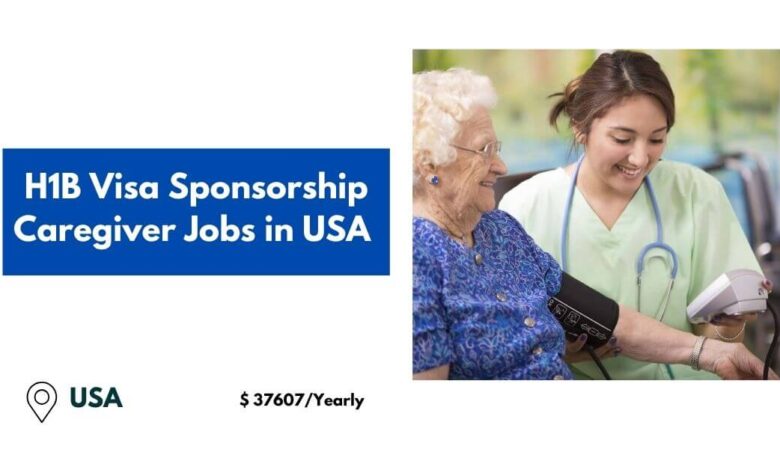H1B Visa Sponsorship Caregiver Jobs in USA 2025 – Apply Now

A nurturer is an individual who assists others when they are in need. The caregiver is responsible for assisting individuals who are unable to complete assignments independently. In the past, caregivers were not compensated, as caregiving was not regarded as a profession.
Nevertheless, caregivers are currently receiving compensation as a result of the availability of professional and qualified caregiving services. You have the chance to pursue employment in this field.
It is crucial to identify enterprises in the United States that will support your visa application. This will motivate your organization to submit a request on your behalf, thereby complicating the process of obtaining a U.S. visa.
It would be advantageous for you to refrain from traveling to the United States of America tomorrow in the absence of a job offer. Regardless, it is feasible to obtain a visa if a family member is requested to foot the bill. This post is intended for individuals who are in search of employment as a caregiver in the United States. It will assist you in obtaining a visa.
Check Also: USA Tailoring Jobs with Visa Sponsorship
Key Points:
- Country: United States of America
- Job: Caregiver
- Education: Diploma in Nursing
- Who can apply? All Nationalities
- Experience: 2-3 Years
- Age: 22-44
- Salary: $37,607 annually
- Visa Sponsorship: Yes
Requirements:
- Have a comprehensive health care professional license, such as that of a doctor, nurse, or adult social worker.
- Pursue a vocation that has a positive impact on social welfare or well-being.
- Employ an organization that is situated in the United Kingdom and has been authorized by the Domestic Office.
- Indicate the obligations of your position within the Joined Together Kingdom by providing your supervisor with a sponsorship certificate.
- The work completed is more important than the minimum wage.
- Tall school recognition or its equivalent is required.
- If applicable, certification or preparation as a Certified Nursing Assistant (CNA) or its equivalent in your home country.
- Proficient in both communication and interpersonal abilities.
- Individuality that is compassionate and kind.
- Able to operate effectively in a fast-paced and demanding healthcare environment.
- The recording of persistent information necessitates proficiency in fundamental computer skills.
Responsibilities of H1B Visa Sponsorship Caregiver Jobs in USA:
- Assisting medical professionals and hospital faculty in understanding the unique requirements of each elderly patient or resident and providing patient-centered care.
- Assistance is rendered to elderly individuals through activities such as bathing, medication organization, meal preparation, and dressing.
- In a manner that preserves dignity, grant senior citizens the authority to supervise their personal hygiene, self-care, and appearance.
- Assisting and coordinating their participation in physical and social activities.
- Physical treatment or any transient movement that promotes movement, such as strolling, would be impractical. Furthermore, it would be impractical to constrain any other recreational or social activity, such as visiting a neighboring relative in a wheelchair or passing by a stop.
- Ensuring that the families of the detainees are kept informed.
- Performing internal reconnaissance regarding security protocols and well-being.
- Each position that medical caretakers and chairpersons request.
- As part of your responsibilities, it is necessary for you to evaluate and supervise the care of elderly individuals.
- Adapt and develop senior care methodologies in accordance with evolving requirements.
- Strive to adhere to the quality compliance standards that govern clinical quality.
- Through collaboration with other members of the multidisciplinary team, it is possible to attain optimal care.
Benefits of H1B Visa Sponsorship Caregiver Jobs in USA:
- Employment Opportunities: Sponsorship of an H1B visa grants access to employment opportunities in the United States’ caregiving sector that may not be accessible in your country of origin.
- Competitive Salaries: In comparison to comparable positions in other regions, caregiver positions in the United States, particularly those sponsored under the H1B visa, frequently offer competitive salaries and benefits.
- Career Advancement: The United States provides opportunities for career growth and development in the healthcare and caregiving sectors, with the potential for advancement into specialized or managerial positions.
- Professional Experience: Acquiring experience in the United States caregiving sector can improve your resume and equip you with valuable skills that are acknowledged on a global scale.
- Healthcare Accessibility: As an H1B visa holder, you may have the opportunity to access employer-provided health insurance and other benefits, which can enhance your overall well-being.
- Work-Life Balance: The availability of flexible scheduling options in numerous caregiving positions in the United States can assist in the preservation of a work-life balance, subject to the specific role and employer.
- Cultural Immersion: The opportunity to engage with diverse communities, explore various regions, and experience American culture is afforded by living and working in the United States.
- Professional Networking Opportunities: Working in the United States enables you to establish a professional network within the healthcare and caregiving sectors, which can be advantageous for career advancement and opportunities.
- Legal Protections: H1B visa holders in the United States are entitled to labor laws that safeguard the rights of workers, such as safe working conditions, equitable wages, and anti-discrimination protections.
- Permanent Residency Option: Depending on your circumstances and visa status, working in the United States on an H1B visa may provide a pathway to permanent residency (a green card) or other long-term immigration options.
- Training and Certification: Numerous employers offer professional development opportunities and training that can improve your qualifications and abilities in the caregiving sector.
- Family Benefits: Your family members may be eligible to accompany you in the United States under dependent visas, and you may be able to access benefits such as education for your dependents, depending on the visa conditions.
Salary:
the average annual compensation for caregivers in the United States is $30,225, or $14.53 per hour. Section-level positions commence at $26,350 annually, while the majority of experienced specialists earn up to $37,607 annually.
How to Apply for H1B Visa Sponsorship Caregiver Jobs in USA?
- The initial step is to obtain employment as a caregiver, with the manager responsible for the visa expense. To locate these positions, you will employ www.indeed.com or any of the numerous other online job search sites. Each of these websites provides a comprehensive list of available positions in the field of caregiving services.
- The subsequent step is to verify that each labor notice satisfies all necessary requirements. It is essential to be aware of this information, as it will assist you in crafting an effective cover letter.
- Afterward, you will utilize the information you have acquired to create a successful cover letter and continuation. It is imperative that your cover letter includes all the essential information that a potential manager would expect to see.
- The subsequent step is to employ the websites to generate applications for as many positions as feasible. This will increase the likelihood that U.S. companies will be interested in contracting with you.
- The supervisor will contact you to discuss the compensation if they believe you are a suitable candidate for the position.
Frequently Asked Questions:
-
How do I get a US visa for a caregiver?
EB-3 Visa. To become a caregiver in the United States of America, the best route is for an employer to sponsor you for the EB-3 (Other Worker) visa. This is a permanent US visa that allows you to live and work permanently in the United States of America.
-
Is caregiver in demand in the USA?
It’s no secret that the demand for caregiver jobs continues to grow. According to a new report, the U.S. will need more than 3.2 million workers within 5 years. For job seekers, this means new opportunities to work in a field where you will always be needed.
-
Can I move to the USA as a caregiver?
To become a caregiver in the United States of America, the best route is for an employer to sponsor you for the EB-3 (Other Worker) visa. This is a permanent US visa that allows you to live and work permanently in the United States of America.



